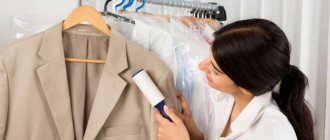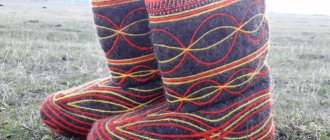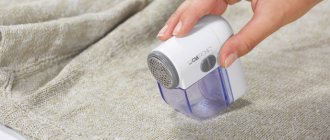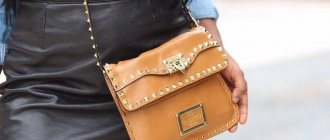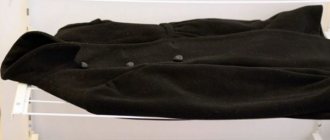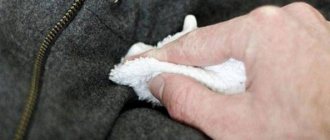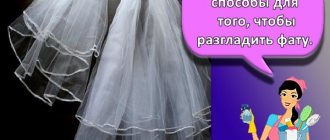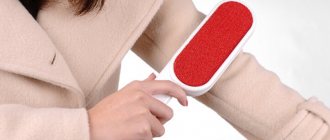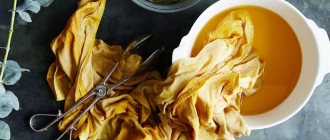During long-term storage in a closet or after improper washing, a coat may become wrinkled and lose its attractive appearance.
In such situations, it becomes necessary to iron outerwear. But how to properly iron a coat?
In order not to spoil the product, it is important to know some rules for caring for it, depending on the type of material from which it is made.
Is it possible?
When sewing this popular outerwear, designers use different materials, including:
- suede,
- skin,
- velours,
- velveteen.
If the product is made from this raw material, it is better not to iron the coat, but to have it dry cleaned.
Most often, such outerwear is made from natural wool or synthetic materials that can be ironed at home. Any creases and folds can be smoothed out; it is enough to know the specifics of such care for the product.
Is it possible to iron a coat at home?
Any coat can be ironed at home, without the cost of dry cleaning. Before the procedure, it is necessary to study the characteristics of different fabrics and find out what type of ironing suits them.
Before ironing, inspect the coat to make sure there are no stains on it. If the item has just been washed, then dry it and only then proceed with the procedure.
Steaming
Steam treatment is considered a more gentle and gentle way to treat fabric. Today, there are various types of special devices for carrying out such care.
However, if you don’t have a steamer at home, you can do without it using the following methods:
Steaming with an iron .
At this stage it is important to create a steam effect using the iron. The product must not be touched with the soleplate of the iron. The device should be set to the lowest temperature. The product must be hung on hangers and each section of the fabric must be processed, paying special attention to creases. Leave to dry completely and hang carefully in the closet.- Steaming in the bathroom .
Hang the coat on hangers in the bathroom, close the door and turn on the hot water. When a steam effect is created in the room, leave the product in it for 20 minutes. After making sure that all wrinkles have disappeared and the fabric has straightened, hang the outerwear in a dry and well-ventilated area to dry completely.
The video will show you how to steam a coat:
Smoothing a wool coat
If your goal is to smooth the fur, then strictly follow the instructions and do not experiment during the procedure. Each product has its own specific cut, which makes the task a little more complicated.
You can iron a wool coat with a regular iron:
- Set the iron to one.
- Cover the fabric with gauze and iron it; if the wrinkles do not disappear, increase the temperature to two.
- The outside is ironed through damp gauze, and the inside is ironed directly.
- First, iron the inside, and after 5 minutes the outside.
- Flatten the wrinkled area with your hands and iron it.
- Sleeves are ironed using a special stand on an ironing board.
- Next, iron over the back, collar, and lapels. To smooth out the hangers, place a hard pad under them.
- The seams are ironed with the tip of the iron last.
A cashmere coat should only be ironed after it is completely dry. This also applies to products made from alpaca wool. It is recommended to iron dark cashmere items from the outside, otherwise light spots will remain on the seams.
You can steam a wool coat using a special device or an iron with a vertical steam option. After all, when using a regular iron, there is a high probability of scorching or holes appearing in the fabric.
Many owners of beautiful woolen coats are interested in the question of whether it is possible to smooth out wrinkles without a steamer or iron. There are 2 ways to tidy up a woolen product without special tools:
- Turn on the hot water in the bathroom and close the door. When the room is filled with steam, hang the coat above the water at a distance of 25 cm. Leave the item in this position for 2 - 4 hours so that the wrinkles are smoothed out. Then take the product out of the bathroom, let it cool and dry.
- Place the coat on the table, straighten out the folds and folds, place a damp terry cloth on the wrinkled areas, and leave the item. After 8 hours, put it on a hanger and let it cool.
The last method is suitable for drape items.
Tips and don'ts when ironing
In order for the process of smoothing out folds and creases on a coat to be effective and safe, it is important to adhere to the following expert advice:
To keep the fabric soft and tender after washing, use a special conditioner; it will make it easier to smooth out wrinkles;- It is better to iron sleeves on special ledges on the ironing board;
- when ironing your shoulders, it is advisable to place a hard pad under the material;
- you need to start steaming the coat at a distance of 20 cm from the fabric, and only when the fabric has warmed up well can it be reduced to 10 cm;
- The seams of outerwear are ironed at the very end of such care; only the nose of the iron is used for this.
There are also some prohibitions , following which you can keep your coat looking attractive without frequent ironing:
- Some wool items cannot be ironed at all; this is indicated on the label. To straighten them out, just hang them on hangers and leave them for a while or place them in a bathroom filled with steam.
- It is strictly forbidden to iron a dirty coat without first washing it. Dirt particles under the influence of high temperature will be absorbed into the fiber even more strongly, and it will be almost impossible to correct the situation.
- Do not rush to iron your outerwear without first reading the label for care instructions.
Synthetic coat
Products made from artificial fibers look great, protect from cold, moisture, and are resistant to stains. However, polyester coats do not withstand high temperatures well. For this reason, before ironing, you need to carefully study the label on the reverse side of the item and select the correct temperature setting.
Owners of spectacular and wear-resistant polyester coats know firsthand that such products rarely wrinkle. However, this is possible if outerwear is not dried properly after washing. If you notice folds or creases, then it's time to iron your coat.
Before ironing, select the appropriate heating temperature on the section located on the inside of the product. To do this, run the iron over the flap, checking the temperature, do not forget to check this value on the label. Having decided on the temperature regime, proceed to full ironing.
If the coat is thin (without filling), then you can iron it from the inside out. A thing with a thick ball of insulation is ironed as follows:
- Clothes are turned inside out.
- Place on the board and smooth out.
- The crumpled area is covered with 2–3 layers of damp gauze or thin cotton cloth and ironed.
- They put it on hangers. Ready!
If the label indicates that the item cannot be ironed, then it is recommended to steam it. A steamer is used for this. Activate the delicate mode, hang the coat on a hanger or holder. During the procedure, hold the device at a distance of 10 cm from the tissue, move it from top to bottom.
They begin to smooth out the folds from the back, then move on to the sleeves, shoulders, front and end with the collar. If you don’t have a special device, then use an iron with a vertical steam option.
After the procedure, let the product cool and dry. But hang it away from heat sources.
General recommendations
The coat can be ironed after washing or purchasing, when creases form on it.
If you wash an item, do not forget to add conditioner when rinsing, this will make ironing much easier. The fabric should be slightly damp.
First you need to clean the surface of the iron from scorch marks and traces of scale, otherwise these contaminants may remain on your clothes. Choose a mode with a temperature no higher than 100 degrees. Be sure to use an ironing iron - a special fabric that is placed between the iron and the material. You need to iron the item from the wrong side.
When processing sleeves, use the armband that is sold with the board, or place a rolled towel inside.
After ironing, leave the coat until it cools completely. And only then put it in the closet.
Tips for fixing small problems
Using simple techniques and small tricks, you can easily preserve the beauty of the product. The most correct method is the prevention of future problems, and the correct elimination of existing ones:
- Long-term storage of a coat implies its free presence in the wardrobe - placing it in a tightly packed closet is not the best option; it is better to find another place for it in the house.
- An effective method for eliminating “wrinkled” seams is ironing with an assistant. The collar or lapel is stretched and ironed through a damp cloth.
- If the fabric has stretched in some place, the method of “planting” the fabric is used. You can find out how to iron a coat in this case on special tailoring websites.
You can almost always return your coat to an attractive appearance on your own without overpaying for dry cleaning services. You just need to carefully follow the manufacturer's recommendations.
Is it possible to iron a coat without an iron?
When it is not possible to use technology, you can also return clothes to their normal appearance. There are ways to iron a wrinkled coat without an iron. One option is to moisten it with a spray bottle and let it hang.
The ideal option is to keep it on the balcony in inclement weather (during fog or drizzle). The air saturated with moisture will saturate the fabric, its fibers will swell and straighten. Plus, pollution will disappear.
Another option to deal with wrinkles on your coat is to hang it over a bathtub with hot water or immediately after taking a shower. The steam will soften the wrinkles and they will smooth out on their own. All that remains is to take the coat into the room to dry.
In order not to subject your coat to unnecessary tests, you need to properly care for it. To do this, keep it on hangers, do not press it in the closet with other clothes. Put away for storage, neatly straightened and buttoned.
How to put things in a suitcase so you don’t have to iron them later
Every person wants things to look as if they had just been ironed after transportation. And for this you will have to learn how to fold clothes correctly.
We put the outfits in a certain order, folding each type of clothing in its own way:
- First, we take trousers and jeans: we place the upper half of the product at the bottom of the suitcase, and temporarily leave the second part outside. We will place the pant legs inside last. We put dresses, jackets and other long items in the same way.
- Next, fold the jackets, pullovers and sweaters: place them face down on a flat surface, fold the sleeves toward the back, and fold the item in half. We put them in even piles in a suitcase on top of a layer of trousers.
- It was the turn of the shirts that had cooled after ironing. First, fasten the buttons. Not everything is possible, but only the top, middle and bottom. This is necessary so that the floors of the product do not diverge to the sides, and the item folds evenly. If the buttons are embossed or simply large, wrap them in thin paper, like tissue paper. This way, fingerprints will not appear on the material. You need to fold the shirt on a flat and preferably hard surface. There are only 8 sequential steps to complete: Lay the shirt face down. Use your palms to smooth the fabric well to remove creases and wrinkles.
- First, fold the left sleeve. To do this, visually draw a straight line from the middle of the left shoulder down, and along this line we wrap the sleeve towards the back.
- We carefully place the sleeve on the folded part of the shirt with the cuff down, aligning it along the edge.
- We wrap the other side of the shirt in the same way.
- Adjusting the right sleeve. At the same time, be sure to ensure that the shirt does not taper downwards. The sleeves should become parallel to each other.
- Fold the bottom of the product along with the cuffs to approximately the width of your palm.
- Fold the bottom part up again, and now this edge should touch the collar.
- Turn the shirt face up and place it in your suitcase.
Video: how to fold a long-sleeve shirt correctly
Watch this video on YouTube
So, if you put all your things in a suitcase in this way, then you won’t have to iron them when you arrive.
There is another method of packing things. Here everything is rolled up together, and not each thing separately. This results in a very compact knot, and the clothes hardly wrinkle.
The pattern of folding clothes in a knot will reduce the time it takes to pack a suitcase and help you fit a huge amount of things without wrinkles.
How to steam a coat at home?
Demi-season and winter coats add elegance and smartness to the image of men and women. Such items are sewn from natural or mixed fabrics, have a lining and often a layer of insulation between the lining and the outer fabric.
To carry out a quick and safe steaming procedure, you must have a modern steamer at home. The best examples of the most famous foreign companies are presented in the catalog of the online store of ironing equipment “Skladok Net”. Compact and versatile home steamers are inexpensive. At the same time, they perform work on steaming and ironing clothes, disinfecting laundry, eliminating unpleasant odors, and cleaning various surfaces in the house.
Nuances of care
In conclusion, here are some tips to help you care for coats made from different types of fabric:
- Always store wool coats, especially those made from alpaca and cashmere, on hangers at home. Do not throw other things on it and even when visiting, ask for a separate hanger.
- Do not wear handbags with a long strap along with an alpaca coat to avoid creases and bald patches.
- Carefully straighten your drape coat before storing so that there are no creases on the hem, sleeves, or collar. This material is quite rough and therefore will be very difficult to smooth out.
And don’t forget that proper care of your favorite things will definitely extend their service life, and save you nerves and finances.
What types of curtains are there?
In order to understand how to iron curtains, you first need to know what they are. Most often, this characteristic refers to the material from which they are made. Each fabric has special care requirements, which relate not only to washing (its temperature conditions, the use of machine washing, etc.), but also to ironing. The use of certain fabrics for sewing curtains is dictated not only by interior fashion, but also by the functional purpose of the product.
You can divide curtains according to several criteria, for example:
- by method of application;
- design and shape (for example, vertical or horizontal, complex or simple, “bishop sleeve” or “hourglass”);
- materials.
According to application, curtains are distinguished:
- kitchen, including short window curtains;
- for rooms (living rooms, bedrooms, children's);
- stage;
- interior (zonal);
- for utility and utility rooms, for example, for a bathroom or gazebos;
- automobile;
- innovative (shading or insulating, for example, made of tarpaulin or other dense fabric).
By design, curtains can be distinguished:
- classic;
- curtains of simple and similar cut, including Italian, Austrian, London, Greek type curtains;
- roll;
- Roman curtains;
- thread;
- with lambrequins;
- fabric blinds (vertical and horizontal).
In addition, curtains can be distinguished by the method of fastening on the eaves, namely curtains with fabric loops, with ties, with a drawstring, with grommets, as well as curtains that are not attached to the eaves.
- natural fibers (cotton, linen, natural silk)
- artificial fibers.
The latter are produced industrially, and most often they are made with the addition of synthetic threads. Recently, housewives and interior designers have given preference to thread curtains, because all that needs to be done with such decor for window and door openings is to hang them in place slightly damp and shake them so that the threads hang evenly. These curtains do not require ironing, steaming or other methods. Wrinkle-resistant fibers just need to be washed with any detergent - and they will again delight their owners, creating comfort. It is noteworthy that the wide range of colors of such curtains allows them to be used both in kitchens and living rooms, as well as bedrooms, balconies and loggias.
Difficulties in care and ironing are also noted with polyester products, velvet and heavy curtains. But the most difficult to iron and care for are curtains that have lambrequins, tiered folds and complex designs made from any of the listed fabrics.
How to smooth difficult things with a steamer
What cannot be ironed well with an iron can be tidied up with a steamer.
Fur coat
It is very difficult to smooth out a natural fur coat on your own. If clothes have been stored incorrectly, they will go straight to the dry cleaner. But if you have a steamer at home, your fur coat will be ready to wear in a few minutes.
Place the fur coat on a flat surface. Warm up the device and pass it once over each part of the product. Then flip and repeat.
Trousers
Pants treated with a steam cleaner look five stars. Hang your trousers on the trempel with the waist down. Run the hot steam cleaner from top to bottom several times.
If you want to make straight arrows, your set of attachments should have the right ones. If you don't have one, use kitchen tongs. First, draw the crease with your hands, then run the steamer over the trousers and then form the crease with tongs.
How to smooth difficult things with a steamer
Delicate items
To iron delicate items, you need to reduce the power of the tool to half. If you do not have this function, simply increase the distance of the device from the fabric. Be sure to hang the delicate item on a trampoline so that the steam can pass through it.
Kids toys
It is very good to iron children's soft toys with steam. They become cleaner and completely disinfected. It is enough to treat toys once a week.
Put the device on full power, and then run it several times on each side of the toy. With regular cleaning, you won't even need to wash your stuffed toys.
How to iron with a steamer - a guide that will help you expand the use of your device at home.
Is it possible to iron paper with an iron?
In general, you can use an iron to restore wrinkled documents. The method of leveling with an iron is the most famous, and one of the riskiest. You can use it, but you need to do everything carefully, following the rules.
How it all happens
The crumpled paper needs to be smoothed out as much as possible so as not to make new bends.
Cover with a towel or cloth to protect it from extreme heat. Set the iron to the lowest power, gradually increasing the temperature in the process; at higher temperatures, the paper may turn yellow. After ironing one side, the sheet must be turned over and the procedure repeated.

